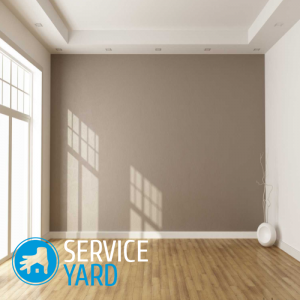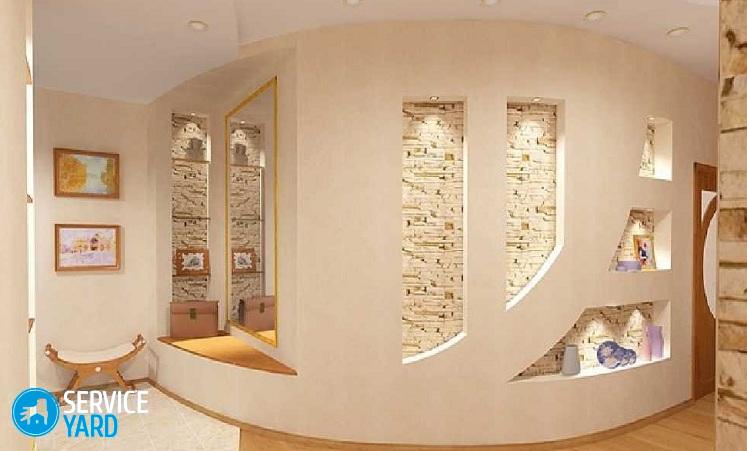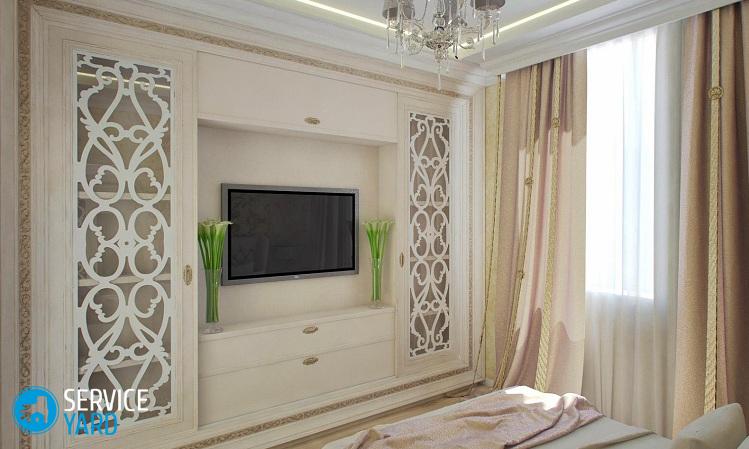How to make a drywall wall?

When arranging your home, it often becomes necessary to erect new partitions and internal walls in the apartment. This can be either a full-scale redevelopment of housing, or the desire to split the existing room into parts and form rooms in a new building, which today, as a rule, are performed in a single space.
For the construction of internal partitions, drywall and metal profiles are used. This material is so convenient and easy to use that you can understand how to make a wall of drywall with your own hands, even without assistance. However, in the process of forming walls from GCR, there are many important nuances that must be taken into account in the process. Only in this way can a reliable design be obtained that can last a long time.
to contents ↑The main characteristics of drywall
Drywall has a number of undeniable advantages compared to other options for wall decoration in different rooms. Here are some of the most significant of them:
- Acceptable price.
- Easy to do it yourself.
- Fire resistance and moisture resistance.
- Environmental Safety.
- The ability to give the necessary shape.
- Convenience of installation of sound and noise insulation, lighting.
- Combination with other materials.
What material is better to make a wall of drywall with your own hands? To do this, you can use several types of sheets from the manufacturer Knauf:
- Standard (GKL) for dry rooms.
- Moisture resistant (GKLV), almost universal, which is suitable for rooms with any humidity.
- Fire resistant (GKLO) for rooms with increased risk of fire.
- A sheet that combines two advantages - moisture resistance and fire resistance (GKLVO).
to contents ↑Important! For ordinary rooms of city apartments (except for the bathroom), it is better to use ordinary sheets with which you can make almost any curly design.
Materials for work
Before you build a wall from drywall, first you need to determine what we need to build a wall of materials and what kind of tools we have to work with.
In order to ensure the strength and the correct configuration of the wall, it is necessary to initially erect a frame. It is made of a metal profile, which is specially designed for drywall from a number of auxiliary devices for its installation.
Profiles - types, features
The profile is mainly used in two main sizes:
- D - for the manufacture of the plane on which the drywall will be attached (smaller).
- W - to form a common wall frame (larger).
Important! In addition, for each standard size, profile options are provided as a reference (C) and a guide (U):
- The guide option is a simpler view of the U-shaped profile with smooth walls, a supporting profile is inserted into it with the end face.
- In addition, in the U-shaped form, the supporting profile has a special ribbing, which is pressed to obtain greater bending stiffness.
Eventually:
- CD - size 60x27 mm is the main supporting element of the frame.
- UD - size 28x27 mm is a guide for the CD profile.
- CW - size 50x50, 50x75, 50x100 mm is a rack profile for forming a wall frame.
- UW - size 50x40, 75x40, 100x40 mm is a guide for the CW profile.
- UA - is a variant of CW - profile, but reinforced with a thicker wall.
Important! In order to make a wall of drywall with a width of 50, 75, 100 mm, only profiles CW and UW can be used. To create wider walls with laying of communications, the CD and UD profile is used, while two guides (parallel) are installed on each side of the wall at the required distance.
Fasteners:
- To mount the profile in the frame, a direct suspension and a universal connector (crab) will be required. You can do without the latter.
- The elements should be twisted with self-tapping screws with a “drill” tip, as well as with self-tapping screws for fixing drywall on metal with a countersunk head and a piercing tip (3.5x35 mm).
- To fix the entire frame to the walls, plastic dowels with impact screws are required.
Sheet material
To build a wall, drywall sheets are selected with a thickness of 12.5 mm, without fail with a wide bevel on the sides. In the event that the wall is made in the bathroom or in the kitchen, then a moisture-resistant type of GCR is used. They differ in color: the moisture-resistant sheet is green, and the usual one is gray.
to contents ↑Important! As a result - for the construction of the wall you will need: drywall, profile CD, CW, UD, UW, profile AU or wooden beam, dowels, mineral wool, sealing tape, metal corner.
Instruments
In order to build a wall from drywall, you will need the following tools:
- Level (120 cm, 80 cm).
- Roulette.
- Fishing line.
- Plumb line.
- Reversible drill or screwdriver.
- Fishing line.
- Scissors for metal.
- Perforator.
- Torca for drywall.
- Construction knife.
The beginning of the installation of the wall frame made of drywall
So, with the definition of the necessary profiles and the preparation of tools is completed, you can begin to plan and place the future wall. The floor and the adjacent wall, on which the new wall will be fixed, must be at the stage before finishing, that is, the walls are plastered, and the floor is even with a screed.
General nuances
For example, let's look at the formation of a wall from the profile CW, UW. On the floor, it is necessary to mark the placement of the future wall. The following nuances are taken into account:
- Almost nowhere to find in the rooms perfectly right angles between the walls. This is especially true of old houses. At different ends, the distance between them may vary by several centimeters. When marking a new wall, it is necessary to take this moment into account and not be tied to one wall, but to both, running in parallel. In this case, the distances are averaged. So you can prevent the visual curvature of the resulting room.
- In the event that, in addition to installing the wall, plasterboard lining of all the walls is carried out, then the frame is first displayed, or at least the marking of the casing is done so as to make the most right angles. After that, you can only begin to build walls.
- When marking the first line where the wall will be located, it must be taken into account that the guide profile will be aligned along it, and not the resulting wall. To this mark will be added the thickness of the GCR, a layer of putty, as well as finishes.
Wall and ceiling marking
After you decide on the first line on the floor, you can begin to transfer it to the walls and ceiling. To do this, use a plumb line. If it is possible to use a laser beam, then this greatly simplifies the task.
Important! All profiles in order to make a wall of drywall, which are fixed to the floor, existing panels or ceiling, are installed using a sealing tape between the supporting surface and it. The first UW profile rails are mounted on the ceiling and floor. They are fixed at the edges every half a meter with dowels, as well as impact screws.
Fastening profiles - features of work:
- At the edges of the rails, the support posts of the CW profile are fixed.
- Also, the racks are mounted in places where a window or doorway will be formed, which are needed when erecting a wall of drywall between the rooms.
- Profiles are best fixed on the bottom rail first. Then it is threaded into the upper guide and installed in a level strictly vertical.
Important! When placing these profiles, the margin for plasterboard strips over the profile is taken into account.
- Profiles are mounted with the front side inside the opening. Fastening racks to the rails is done using self-tapping screws.
- Support profiles along the perimeter of window and doorways should be strengthened with wooden blocks inserted into the profile and fixed with screws.
Important! The bar must be selected in accordance with the width of the profile. If the AU profile is used, then it is quite possible to do without bars.
- The next step is the installation along the entire length of the frame of the CW support profiles vertically. The first profile from the adjacent wall is installed at a distance of 55 cm, all subsequent ones at a distance of 60 cm from each other, measuring the distance from the middle of each of the profiles.
Important! Be sure to check the vertical installation of profiles.
- To indicate the top of the doorway, as well as the horizontal edges of the window openings, the same UW profile is used. A piece of profile is cut off 30 cm more than the width of the opening. On the bend of the side bends of the front side of the profile, marks are placed at a distance of 15 cm from each edge. The sides of the profile should be cut at an angle of 45 degrees, starting from the side of the edge of the profile to the mark and to the base of the profile. Then the edges of the profile are bent, and a U-shaped structure should be obtained.
- The resulting workpiece with curved edges is put on racks on the sides of the opening and rises to the required height. Fastens with self-tapping screws, which fix the edges of the profile to the posts. The obtained oblique ears formed on the main part of the workpiece are also attached. The perimeter of window openings is formed by the same principle.
- At this work on the formation of the frame can be called completed. Now you can proceed to the process of fixing sheets of drywall. As a rule, the dimensions of the sheets are standard: 1200x3000, 1200x2500, 1200x1200. Often the ceilings in the living quarters are higher and are at least 2.75 m, so the height of one sheet may not be enough.
to contents ↑Important! The first sheet, installed close to the edge, most often the adjacent wall should be removed from the side chamfer. To do this, on the one hand, a strip whose width is 50 cm is cut along its entire length.
Drywall Cutting
Before you make a wall of drywall, you need to cut it. For this, an ordinary construction knife with interchangeable blades is used:
- The sheet must be placed necessarily on a flat surface.
- Using a pencil, a cut line is marked and a knife makes an incision of the top layer of cardboard.
- After that, the sheet is shifted along the incision line to the edge of the support and is carefully broken off.
- Returning the sheet to its original position, it is deployed on the edge, and then bent.
- On the other side, the cardboard is also cut, but not through.
- After the sheet is turned over and the edges of the support are displaced, it can be finally chopped off.
to contents ↑Important! In order to ensure a gap that can be qualitatively repaired later by puttying, a bevel chamfer with a slope of 22.5 degrees is made on the cut edge of the sheet. To do this, use a special planer for drywall. Also, a chamfer is made on the edge of the sheet, which will be adjacent to the GCR strip, located below or above the sheet.
Drywall Mounting:
- Fasten the sheets to the metal frame to make a wall of drywall, it is necessary with the help of screws 3.5x35 mm.
- First, the edges of the sheet are attached, and then along the edges and the midline. To do this, there is a special marking that marks the position of the screws every 25 cm.
- The distance between the screws can vary from 10 to 25 cm, but no more.
- Self-tapping screws should be screwed in such a way that the caps are slightly deepened in the gypsum board or do not peek above the wall.
Important! Sheet fasteners are made at a distance of about 15 mm from the floor. This is necessary to ensure the integrity of the structure during operation.
- After fixing the first sheet, the remaining distance to the ceiling is measured and the corresponding piece is cut from the GCR. A chamfer is also made on it from the sides, where it will lie on the top or bottom sheet and on the ceiling.
- Subsequent sheets are mounted entirely without chamfering and staggered. That is, after the first row a whole sheet of drywall is installed under the ceiling, and the bottom part is missing.
Thus sheathe one side of the wall.
to contents ↑Bookmark wiring, installation of switches, sockets
Before starting the sheathing of the second side, if necessary, you can lay the wires:
- To pass through the rack profiles, holes of 3.5 cm in size are made in them, strictly in the middle of the profile at the desired height.
- It is better when the edges of the hole were concave in one direction and bent so as not to damage the wires.
to contents ↑Important! The wires are mounted in accordance with the requirements in corrugated pipes.
Soundproofing
In order to make a wall of drywall with good sound insulation, mineral wool is used:
- It is easier to use a roll version of this material with a width of 60 or 120 cm. The second option is a sheet one, cut in half lengthwise.
- Cotton wool is laid tightly without gaps between the rack profiles. Somehow additionally there is no need to fix it.
- For greater reliability, you can make horizontal lintels from a wooden beam along the width of the wall, on which minvat will then rest on a shorter length than the height of the ceilings.
to contents ↑Important! This method is suitable for places where there is a possibility of moisture entering the wall. However, it is necessary to ensure adequate ventilation of the internal space.
Drywall completion
After this, you can begin to sheathe the second side of the wall. After the second side is sheathed, you can begin to fill all the end surfaces:
- Between the drywall sheets there is a distance of 100 mm, formed by chamfers, which is somewhat recessed. The joints should be glued with a mounting net in a serpentine and compared with the general level of the wall with starting putty.
- With the help of finishing putty, all places of installation of self-tapping screws or completely all surfaces are leveled, especially if in the future the wall will be glued with thin wallpaper or painted.
- Using a grater and abrasive mesh, the putty layer is finally leveled.
- After that, the wall is considered ready for facing with any suitable material.
Stock footage
Finally, we recall that the installation of the wall from drywall with your own hands should be done slowly, having carefully thought out everything and prepared everything you need. Have a good repair!
- How to choose a vacuum cleaner taking into account the characteristics of the house and coatings?
- What to look for when choosing a water delivery
- How to quickly create comfort at home - tips for housewives
- How to choose the perfect TV - useful tips
- What to look for when choosing blinds
- What should be running shoes?
- What useful things can you buy in a hardware store
- Iphone 11 pro max review
- Than iPhone is better than Android smartphones





